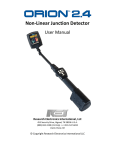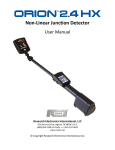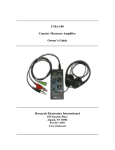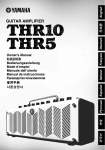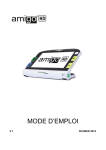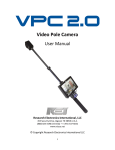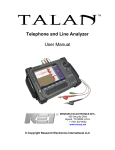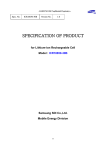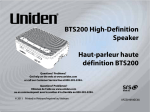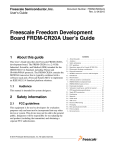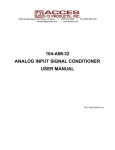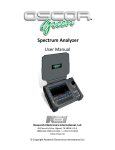Download Non-Linear Junction Detector - Research Electronics International
Transcript
Non-Linear Junction Detector User Manual Research Electronics International, LLC 455 Security Drive, Algood, TN 38506 U.S.A. (800) 824-3190 (US Only) • +1 931-537-6032 www.reiusa.net © Copyright Research Electronics International LLC 2 Non-Linear Junction Detector This document is intended to provide guidance and instruction on using the ORION 2.4 Non-Linear Junction Detector for finding hidden electronic devices. This manual contains proprietary information intended solely for use with the ORION 2.4 Non-Linear Junction Detector. The overall effectiveness of this product, and of any surveillance countermeasure, is dependent on the threat level and the user’s ability to properly utilize the appropriate equipment. The REI Training Center offers training on technical surveillance countermeasure equipment. 3 Revision 1.16 © COPYRIGHT RESEARCH ELECTRONICS INTERNATIONAL REI products are designed and intended for legal commercial applications, however because laws and regulations vary from state to state and country to country, it is the sole responsibility of the purchaser and user/operator to check and comply with all applicable laws and regulations for the possession and operation of this equipment before and after making a purchase. WARNING: It is the responsibility of the user to comply with the appropriate radio communication laws of the country in which the ORION 2.4 is being used. This device complies with part 15 of the FCC Rules. Operation is subject to the following two conditions: (1) This device may not cause harmful interference, and (2) this device must accept any interference received, including interference that may cause undesired operation. This device complies with Industry Canada license-exempt RSS standard(s). Operation is subject to the following two conditions: (1) this device may not cause interference, and (2) this device must accept any interference, including interference that may cause undesired operation of the device. Cet appareil est conforme avec Industrie Canada RSS standard exempts de licence (s). Son utilisation est soumise aux deux conditions suivantes: (1) cet appareil ne peut pas provoquer d'interférences et (2) cet appareil doit accepter Toute interférence, y compris les interférences qui peuvent causer un mauvais fonctionnement du dispositif. Information contained in this manual including product operation and specifications is subject to change without notice. Any product or brand names contained in this manual are used only for identification purposes and are trademarks or registered trademarks of their respective holders. Patents Pending OWNER’S RECORD The Serial Number of each ORION 2.4 is located on the bottom of the unit near the battery compartment door. Please record this number and refer to it whenever you contact your dealer or Research Electronics International concerning this product. Note: Removal or alteration of the serial number automatically voids all warranties of this product. SERIAL NUMBER: _________________________ Research Electronics International, LLC 455 Security Drive, Algood, TN 38506 U.S.A. (800) 824-3190 (US Only), +1 931-537-6032 www.reiusa.net 4 This device has been tested and complies with the essential requirements of the following CE directives: LVD Directive 2006/95/EC EMC (Electromagnetic Compatibility) Directive 2004/108/EC However, additional restrictions may need to be observed depending on where this product is used. Please consult the table below for a list of required restrictions by country. To operate the equipment legally, it must be operated within these restrictions for the given country. See Page 25 for details on how to configure the ORION 2.4 to operate within these restrictions. Country Restrictions Austria (AT) Belgium (BE) Bulgaria (BG) Cyprus (CY) Czech Republic (CZ) Denmark (DK) Estonia (EE) Finland (FI) France (FR) Germany (DE)* Greece (GR) Hungary (HU) Iceland (IS) Ireland (IE) Italy (IT) Japan Latvia (LV) Liechtenstein (LI) Lithuania (LT) Luxembourg (LU) Malta (MT) Netherlands (NL) Norway (NO) Poland (PL) Portugal (PT) Romania (RO) Slovak Republic (SK) Slovenia (SI) Spain (ES) Sweden (SE) Switzerland (CH) United Kingdom (UK) 100 mW Max Transmit Power No restrictions 2.446 GHz to 2.454 GHz Transmit Freq Range No restrictions No restrictions No restrictions No restrictions No restrictions 10 mW Max Transmit Power 25 mW Max Transmit Power No restrictions 10 mW Max Transmit Power No restrictions No restrictions 10 mW Max Transmit Power 10 mW Max Transmit Power No restrictions 10 mW Max Transmit Power 10 mW Max Transmit Power No restrictions No restrictions No restrictions No restrictions No restrictions 10 mW Max Transmit Power No restrictions No restrictions 10 mW Max Transmit Power No restrictions No restrictions 10 mW Max Transmit Power No restrictions “Country” setting for ORION 2.4 (see Page 25) Austria FCC/IC/CE Bulgaria FCC/IC/CE FCC/IC/CE FCC/IC/CE FCC/IC/CE FCC/IC/CE France Germany FCC/IC/CE Hungary FCC/IC/CE FCC/IC/CE Italy Japan FCC/IC/CE Liechtenstein Lithuania FCC/IC/CE FCC/IC/CE FCC/IC/CE FCC/IC/CE FCC/IC/CE Portugal FCC/IC/CE FCC/IC/CE Slovenia FCC/IC/CE FCC/IC/CE Switzerland FCC/IC/CE * Note: The operator violates German law if the unit is operated with a higher power than permitted. Fine regulation of TKG §148 and §149 could apply. Units shipped into Germany will be preset with the German Country setting. 5 Table of Contents PRECAUTIONS ............................................................................................................................................... 9 Equipment Description ............................................................................................................................... 10 Overview ................................................................................................................................................. 10 Keypad .................................................................................................................................................... 11 SET-UP & BASIC OPERATION ................................................................................................................... 12 Battery Usage .......................................................................................................................................... 12 Real Time Clock Battery .......................................................................................................................... 13 Procedure................................................................................................................................................ 14 Basic ORION 2.4 Functions ...................................................................................................................... 15 Power On/Off ...................................................................................................................................... 15 Operation/Menu Item: Transmit Power Level.................................................................................... 15 Auto / Manual Transmit ...................................................................................................................... 15 Frequency Adjust ................................................................................................................................ 15 Volume Level ....................................................................................................................................... 16 Volume Mute ...................................................................................................................................... 16 Adjusting the Menu Items ...................................................................................................................... 17 Menu Structure ....................................................................................................................................... 17 Quick Access Buttons .............................................................................................................................. 18 Menu Items / Operations........................................................................................................................ 18 Search Mode Audio: Tone................................................................................................................... 18 Tone Alert Type: 2nd Only .................................................................................................................... 18 Tone Alert Type: 3rd Only ................................................................................................................... 19 Tone Alert Type: 2nd & 3rd ................................................................................................................... 19 Tone Alert Type: 2nd & distinctive 3rd .................................................................................................. 19 Audio: Listen 2nd AM ........................................................................................................................... 20 Audio: Listen 2nd FM ............................................................................................................................ 20 Audio: Listen 3rd AM ............................................................................................................................ 20 Audio: Listen 3rd FM ............................................................................................................................ 20 Gain Level ............................................................................................................................................ 21 6 Auto/Manual Transmit Power ............................................................................................................ 21 Manual Frequency Adjust ................................................................................................................... 21 Auto Frequency Mode ........................................................................................................................ 22 Alert: Trip Level ................................................................................................................................... 22 Vibrate Setup ...................................................................................................................................... 22 Speaker: Headphones Only ................................................................................................................. 23 Speaker: Headphones or Speaker ....................................................................................................... 23 Flashlight Setup ................................................................................................................................... 23 Display Brightness ............................................................................................................................... 23 Keypad Backlight Setup....................................................................................................................... 24 Standby Mode Setup........................................................................................................................... 24 Auto Off Mode Setup .......................................................................................................................... 24 Show Clock .......................................................................................................................................... 24 Set Clock .............................................................................................................................................. 24 Save/Recall User Settings.................................................................................................................... 25 Restore User Settings .......................................................................................................................... 25 Country Setting ................................................................................................................................... 25 Battery Status...................................................................................................................................... 27 Display REI Information / System IDs.................................................................................................. 27 Specifications .............................................................................................................................................. 28 APPENDIX .................................................................................................................................................... 30 Background Theory ................................................................................................................................. 30 7 Technical Security Training REI Training Center: REI offers the world’s largest commercially available Technical Security training facility. Training courses include classroom instruction and hands-on exercises where students perform sweep exercises in “live” environments utilizing “target rich” project rooms. The progressive course curriculum is designed for the beginner or the seasoned Technical Security Technician. Regularly scheduled courses are taught monthly; visit REI’s website (www.reiusa.net) or contact REI ([email protected]) for training dates. Contact REI for more information about technical security training and/or other equipment: www.reiusa.net 8 PRECAUTIONS PRECAUTIONS ORION 2.4 • • • • • • • • CAUTION: Any changes or modifications not expressly approved by REI could void the user’s authority to operate the equipment. The ORION 2.4 is for professional use only. The ORION 2.4 is capable of emitting a radio signal between 2.404 GHz and 2.472 GHz. The ORION 2.4 meets USA FCC transmission requirements and has been CE marked, however, it is the responsibility of the user to practice good safety procedures. In doing so, you should take the following precautions: o Do not point the antenna at a person’s eyes or head. o Maintain a distance of at least 28 cm between the antenna and the body of the user or nearby persons o Do not leave the antenna in close proximity to any part of the body for more than 5 minutes. o Do not use near flammable fluids or explosives or in any area where the use of radio communications equipment is prohibited. o Do not use in close proximity to any person fitted with a heart pacemaker, heart defibrillator, or any other life support device. For your own safety do not use the ORION 2.4 if: o The ORION 2.4 cables or its plugs become frayed or otherwise damaged. o The ORION 2.4 housing is cracked or otherwise damaged. o You suspect that the unit requires servicing Only use REI approved power sources, batteries, chargers, and accessories. The supplied power supply is REI #UIB345-15. The supplied battery pack for CE units: RRC Power Solutions Lithium Ion Rechargeable Battery pack Model #RRC2040, rated 11.25V, 2950mAh, 33.2Wh. The supplied battery pack for non-CE units: Inspired Energy Lithium Ion Rechargeable Battery pack Model #NC2040HD, rated 10.8V, 2.9Ah, 31Wh. The supplied real-time clock battery is a CR2032 coin cell battery with the following specifications: 3V nominal voltage, 225mAh nominal capacity, -30°C to 60°C operating temp The ORION 2.4 should not be used for normal operation while charging a battery in the ORION 2.4 unit. To return to normal operation, disconnect the AC power supply. There are no serviceable parts inside. Contact your dealer or Research Electronics International, LLC for repairs. Opening the unit will void the warranty. For your own safety do not use the AC power battery charger if: o The battery charger cables or its plugs become frayed or otherwise damaged. o The battery charger housing is cracked or otherwise damaged. o The battery charger is exposed to rain, liquid or excessive moisture. Lithium-Ion Batteries • • CAUTION: RISK OF EXPLOSION IF BATTERY IS REPLACED BY AN INCORRECT TYPE. DISPOSE OF USED BATTERIES ACCORDING TO THE INSTRUCTIONS. For your own safety do not use any ORION 2.4 battery if: o The battery case is cracked or otherwise damaged. o The battery is excessively hot or warm for any reason. Avoid shorting the battery, immersing in water, or exposing to fire. Also, avoid excessive physical shock or vibration. Only use the specified REI battery chargers or products to charge REI batteries There are no serviceable parts inside the battery. Contact your dealer or Research Electronics International, LLC for repairs. Opening or puncturing the unit can be dangerous and may result in injury. Using the Lithium-Ion batteries in a manner not specified by this user’s guide may override the equipment’s built-in protection mechanisms. Keep out of the reach of children. • Dispose of Lithium-Ion batteries in accordance with local regulations. • • • • • 9 Equipment Description Overview 2 5 3 1 7 4 6 8 1. ANTENNA – located on opposite side of head display 2. HEAD DISPLAY – LED Bargraphs for indicating Transmit Power level, 2nd & 3rd Harmonic levels and a small informational display for indicating status and displaying the menu. 3. KEYPAD – used for controlling the ORION 2.4 4. HEADPHONE JACK – for connection of headphones to monitor audio from the unit 5. USB CONNECTOR – used for connecting to a PC for software updates 6. SPEAKER – used to monitor audio from the unit 7. POWER INPUT (under battery door) – for connecting AC adapter for charging (only use REI supplied AC Adapter) 8. BATTERY DOOR / BATTERY DOOR LATCH – conceals battery compartment 10 Keypad 1 5 3 2 7 6 4 8 1. POWER – Press to Power on. Press and hold while the unit is on to Power off. A tap of the power button while the unit is on allows for quick selection of the Transmit Power Mode (Auto or Manual) 2. AUDIO – Press and hold to Mute and Unmute the speaker or headphone. A tap of the audio button allows for quick selection of the audio alerts. 3. TRANSMIT POWER INCREASE / UP ARROW – Increases Auto Transmit Power maximum or Manual Transmit Power level depending on current Transmit Power mode (Auto or Manual). When a menu or menu item is on the screen, this button acts as a navigational control. 4. TRANSMIT POWER DECREASE / DOWN ARROW – Decreases Auto Transmit Power maximum or Manual Transmit Power level depending on current Transmit Power mode (Auto or Manual). When a menu or menu item is on the screen, this button acts as a navigational control. 5. VOLUME DOWN / LEFT ARROW – Decreases the volume. When a menu or menu item is on the screen, this button acts as a navigational control. 6. VOLUME UP / RIGHT ARROW – Increases the volume. When a menu or menu item is on the screen, this button acts as a navigational control. 7. SET – When a menu is on the screen, this button sets the currently active menu item. With no menu on the screen, this button can be used to adjust the transmit frequency (see page 15). Press and hold this button to turn on or off the flashlight. 8. MENU – Displays the Top Menu. If a menu is displayed, this button exits the Menu. 11 SET-UP & BASIC OPERATION The ORION 2.4 has been designed for quick and easy deployment. Depending on your application, some adjustments to the default setting may need to be made. Battery Usage Lithium-Ion rechargeable batteries have been included with your unit. To insert or switch out a new battery: 1. While pressing the latch on the bottom of the grip housing unit, raise the battery door at the rear of the unit. 2. Slide the battery into the battery slot observing proper contact alignment until it latches into place. 3. Close the battery door. The ORION 2.4 has a built-in battery charger. To charge the battery in the unit: 1. While pressing the latch on the bottom of the grip housing unit, raise the battery door at the rear of the unit. 2. With the battery already inserted in the unit, connect the provided AC power supply to the jack located just above the battery slot and to an AC source. The battery will begin charging. Charging is automatic; it will stop when the battery is fully charged. The OLED display on the head indicates the battery charge status during charging. Note: The ORION 2.4 should not be used for normal operation while charging a battery in the ORION unit. To return to normal operation, disconnect the AC power supply. 12 Note: To keep the battery in good working condition, it should be removed from the ORION 2.4 for long term storage of 90 days or more. Even when powered off, the operating system of the ORION 2.4 continues to use a low stand-by current that in some cases could cause a deep discharge and possible damage to the battery, preventing a normal recharge. Real Time Clock Battery An internal CR2032 coin cell battery provides power for the real time clock function and for maintaining saved user settings. The Real Time Clock (RTC) battery should provide years of service. In the event that the clock on the ORION 2.4 stops functioning or user settings are no longer saved, the Real Time Clock battery will need to be replaced. To replace the Real Time Clock battery: 1) Open the battery door and remove the product’s Lithium Ion Battery. 2) Remove the Phillips head screw in the panel above the battery compartment. 3) Slide the battery tray that rests above the battery compartment out of the unit. Do not disconnect the cable attached to the circuit board. 4) Locate the CR2032 battery on the right side of the battery tray circuit board. 5) Remove the old CR2032 battery from the battery clip and replace with a new CR2032 battery. Observe the battery polarity marking on the holder clip when replacing the battery; the positive (+) side should be facing up, away from the circuit board. 6) Replace the battery tray and secure with the Phillips head screw. Be careful not to pinch the attached cable while positioning the battery tray. Do not force the battery tray – the tray rests along plastic ridges in the side of the battery compartment. If positioned correctly, it should slide easily into place. Note: The provided internal coin cell is a CR2032 battery with the following specifications: 3V nominal voltage, 225 mAh nominal capacity, -30°C to 60°C operating temperature. 13 After taking the ORION 2.4 out of the case, follow these simple steps to begin using it: 1. Place one of the provided rechargeable batteries in the battery compartment 2. Rotate the head for easy viewing 3. If preferred, extend the telescoping pole to a convenient length Procedure When the ORION 2.4 is turned on, it scans the Transmit, 2nd Harmonic, and 3rd Harmonic spectrums and automatically selects a quiet frequency avoiding any interference. The operator may also manually select frequencies. Two test tags are included with the ORION 2.4. One is a semiconductor diode to simulate an electronic device. The second is a steel wool pack, to simulate a corrosive metal-to-metal junction. These tags can be used to verify the proper operation of the ORION 2.4. There are two basic procedures to using any Non-Linear Junction Detector: 1. Detecting a non-linear junction and 2. Discriminating between electronics and false detection The ORION 2.4 can be configured multiple ways to aid in these two processes. 14 Basic ORION 2.4 Functions Power On/Off To Power on or off the unit: 1. With the unit off, press and release the Power button to turn the unit on. 2. With the unit on, press and hold the Power button to turn the unit off. Operation/Menu Item: Transmit Power Level The Transmit Power Level may need to be adjusted depending on several factors, including the target or detection range. To manually adjust the Transmit Power Level: 1. Repeatedly press the Up Arrow button to increase the transmit power. The TX1 Green Bar graph will increase corresponding to the increase in transmit power. The OLED Display above the bar graphs will display the numerical value of the transmit power level. 2. Repeatedly press the Down Arrow button to decrease the transmit power. The TX1 Green Bar graph will decrease corresponding to the decrease in transmit power. The OLED Display above the bar graphs will display the numerical value of the transmit power level. Note: Whenever a menu is on the screen, the Up Arrow and Down Arrow serve as navigation keys for the menu. To adjust the Transmit Power Level, confirm that no menu is displayed. To exit a menu, press the Menu button again or wait about 10 seconds for the menu to time out. Auto / Manual Transmit The ORION 2.4 can be operated in either auto transmit mode or manual transmit mode. In auto transmit mode, the transmit power will automatically reduce whenever the receiver becomes saturated. In Manual transmit mode, the transmit power remains at the same level unless it is manually changed. To toggle between Auto Transmit mode and Manual Transmit Mode: 1. With the unit on & with the Transmit Power adjusted so that the Transmit Power is not OFF, press and release the Power button. The Transmit Power Mode Sub-Menu will be displayed. 2. Select the desired mode, “Manual” or “Auto”, from the sub-menu. Frequency Adjust In order to detect electronic devices, the ORION 2.4 transmits a signal and then looks for reflections of this signal at harmonic frequencies (see the Appendix for additional detail on how the ORION 2.4 works). The frequency of this transmit signal can be adjusted from 2.404 GHz to 2.472 GHz in 1 MHz steps. 15 To adjust the transmit frequency: 1. With no menu on the screen, press the Set button . The OLED screen will display a frequency adjust menu. 2. Press the left or right arrow buttons, or , to adjust the transmit frequency. Note: Even with no menu on screen, if a "SEMICOND" or "CORROSIVE" alert is displayed on screen, it will block the frequency adjust menu. The transmit frequency can also be adjusted using the menu, which will allow you to monitor the ambient environment to select a quite channel (see page 21). Volume Level In addition to bar graphs and the OLED display, which give visual cues whenever a hidden electronic target is detected, the ORION 2.4 also has several operation modes, which give different audio cues whenever targets are detected. For details on these operation modes, see the appropriate sections later in this User’s Manual. These audio cues can be received either through the provided speaker on the unit or through headphones. To adjust the audio level of the ORION 2.4: 1. Repeatedly press the Right Arrow button to increase the volume. The OLED screen will display the volume level as it increases. 2. Repeatedly press the Left Arrow button to decrease the volume. The OLED screen will display the volume level as it decreases. Note: Whenever a menu is on the screen, the Left Arrow and Right Arrow serve as navigation keys for the menu. To adjust the Volume Level, confirm that no menu is displayed. To exit a menu, press the Menu button again or wait about 10 seconds for the menu to time out. Volume Mute To quickly mute the volume level: 1. Press and hold the Audio button until the audio silences. 2. Press and hold the Audio button again to return the previous volume level. 16 Adjusting the Menu Items The ORION 2.4 can be configured for multiple situations. The majority of settings changes are handled through the menu. To adjust menu items: 1. Press the MENU button. The Main Menu will appear. 2. Press the Left or Right Arrow to begin scrolling through the Main Menu Items. 3. To enter one of the Main Menu Items, press the Set button when that Menu Item is highlighted. Depending on the Menu Item selected, a configuration change may happen immediately or the user may be presented with a Sub-Menu with additional options. See the following sections for details. Menu Structure MAIN MENU Search Mode Audio Flashlight Toggle Set DSP Gain Frequency Selection Headphone / Speaker selection Setup Menu (See Below) Alert Settings Transmit Power Mode Info Screens SETUP MENU Display Brightness Clock Setup Keypad Backlight Setup Save Settings Standby Mode Setup Recall Saved Settings Country Setting 17 Auto Off Mode Setup Restore User Settings Quick Access Buttons POWER Button: Tap – To change the Transmit Power Mode (Manual or Auto), tap the POWER button while the unit is powered on. Select "Manual" or "Auto" from the sub-menu that appears. Press & Hold – To power down the unit, press & hold the POWER button while the unit is powered on AUDIO Button: Tap – To change the Audio operating mode, tap the AUDIO button. Press & Hold – To mute the volume, press & hold the AUDIO Button until the audio silences. Press & hold the AUDIO button again to return to the previous volume level SET () Button Tap - To change the transmit frequency, tap the SET button (). Press the left or right buttons, or , to adjust the frequency. Press & Hold – To toggle the flashlight on and off, press & hold the SET button () MENU Button Press & Hold – To scan the frequency spectrum to automatically find and select a quiet channel for use, press & hold the MENU button. Menu Items / Operations Search Mode Audio: Tone Purpose: To provide an audible component to target detection. The type of tone heard can be selected using the Tone Alert Type Setting (see below). > (press set button) Access: Menu > > Quick Access: Press the Audio button to quickly access the Search Mode Audio Submenu Tone Alert Type: 2nd Only Purpose: With the Tone Alert Type set to 2nd only, an audible, synthetic tone is heard only when the received 2nd harmonic signal level surpasses the set trip level. As the 2nd harmonic signal level increases, the frequency of the synthetic tone will increase. Note: In addition to setting the Tone 18 Alert Type, the search mode audio must be set to "Tone" and the Volume must be up to hear the alert tone. Access: Menu > > > > (press set button) Tone Alert Type: 3rd Only Purpose: With the Tone Alert Type set to 3rd only, an audible, synthetic tone is heard only when the received 3rd harmonic signal level surpasses the set trip level. As the 3rd harmonic signal level increases, the frequency of the synthetic tone will increase. Note: In addition to setting the Tone Alert Type, the search mode audio must be set to "Tone" and the Volume must be up to hear the alert tone. Access: Menu > > > > (press set button) Tone Alert Type: 2nd & 3rd Purpose: With the Tone Alert Type set to 2nd & 3rd, an audible, synthetic tone is heard whenever the received 2nd harmonic signal or 3rd harmonic signal level surpasses the set trip level. As the signal level increases, the frequency of the synthetic tone will increase. Note: In addition to setting the Tone Alert Type, the search mode audio must be set to "Tone" and the Volume must be up to hear the alert tone. Access: Menu > > > > (press set button) Tone Alert Type: 2nd & distinctive 3rd Purpose: With the Tone Alert Type set to 2nd & distinctive 3rd, an audible, synthetic tone is heard whenever the received 2nd harmonic signal level surpasses the set trip level. As the 2nd harmonic signal level increases, the frequency of the synthetic tone will increase. If the received 3rd harmonic signal level becomes higher than the received 2nd harmonic signal level, a lower frequency tone representing the 3rd harmonic will be heard alternating (or warbling) with the 2nd harmonic tone. Access: Menu > > 19 > > (press set button) Audio: Listen 2nd AM Purpose: Provides an alternate audible response. The received 2nd harmonic signal is AM demodulated and output through the speakers or headphones > (press set button) Access: Menu > Quick Access: Press the Audio button to quickly access the Search Mode Audio Submenu Audio: Listen 2nd FM Purpose: > Provides an alternate audible response. The received 2nd harmonic signal is FM demodulated and output through the speakers or headphones > (press set button) Access: Menu > Quick Access: Press the Audio button to quickly access the Search Mode Audio Submenu Audio: Listen 3rd AM Purpose: > Provides an alternate audible response. The received 3rd harmonic signal is AM demodulated and output through the speakers or headphones > (press set button) Access: Menu > Quick Access: Press the Audio button to quickly access the Search Mode Audio Submenu Audio: Listen 3rd FM Purpose: Access: > Provides an alternate audible response. The received 3rd harmonic signal is FM demodulated and output through the speakers or headphones Menu > > (press set button) > 20 Quick Access: Gain Level Purpose: Press the Audio button to quickly access the Search Mode Audio Submenu Sets the level of digital signal processing integration that is used to process the received signals. Access: Menu > > select desired Gain Level Range: Low, Medium, High Auto/Manual Transmit Power Purpose: To adjust the transmit power level and to switch between automatic and manual transmit modes. In auto transmit mode, the transmit power will automatically reduce whenever the receiver becomes saturated. In auto transmit mode, the set transmit power level is indicated by a blinking LED in the Tx Power bargraph. In Manual transmit mode, the transmit power remains at the same level unless it is manually changed. Menu Access: Menu > > select desired Transmit Power mode Quick Access: Press the Up or Down Arrow ( or ) with no menu on the screen to adjust the Transmit Power Level. Tap the POWER button to get quick access to the Transmit power mode sub-menu. Range: Auto or Manual, 0 to 100% Manual Frequency Adjust Purpose: This mode scans and displays the Transmit, 2nd Harmonic, & 3rd Harmonic spectrums allowing the user to manually select a quiet channel for operation. Menu Access: Menu > > > Press the Set Button () to scan the ambient frequency and manually adjust the frequency or Press the Menu button to set the ORION to Manual Frequency Mode without running a scan. 21 Operation: When Freq Scan mode is first entered, the Transmit Frequency bandwidth is shown. Press the Up or Down arrow to change the bandwidth to the 2nd Harmonic or 3rd Harmonic bandwidth. The selected bandwidth is displayed on the left side of the screen. Press the Left or Right arrow to move the cursor to a quiet frequency. Press the set button to change the transmit frequency of the ORION 2.4 to the cursor frequency. Range: 2.4040 GHz to 2.4720 GHz, adjustable in 1 MHz steps Auto Frequency Mode Purpose: When enabled, the unit will scan the frequency spectrums of the transmitter, 2nd harmonic, and 3rd harmonic to find and select a quiet channel for use, avoiding any interference to and from other devices. The ORION 2.4 also performs this operation on power up as well. Menu Access: Menu > > > Press the Set Button () to run the Auto Scan or Press the Menu button to set the ORION to Auto Frequency Mode without running a scan. Quick Access: Alert: Trip Level Purpose: Press and hold the MENU button to perform an Auto Frequency Scan. To set a trip level for the alert tones, the vibration feedback, and target indicators (“SEMICOND” or “CORROSIVE”). The trip level is indicated by blinking LEDs on the RX2 and RX3 bargraphs. Menu Access: Menu > Range: Vibrate Setup Purpose: > > or to adjust Trip Level 0%, 5%, 10%, 15%, 20%, 25%, 30%, 35%, 40%, 45%, 50% To enable or disable vibrator/haptic feedback Access: Menu > Range: Off, Short, Long > 22 > select desired vibrate level Speaker: Headphones Only Purpose: To shut the speaker on the ORION 2.4 off and operate with headphones only. In this configuration, the speaker will remain OFF regardless of whether headphones are plugged in or not. Access: Menu > If icon is present, select it. The unit will toggle to Headphones Only mode and the Menu. If the mode. icon will be displayed in the Main icon is present, the unit is already in Headphones Only Speaker: Headphones or Speaker Purpose: To allow operation of the ORION 2.4 with either the headphones or the built-in speaker. When no headphones are connected, audio will be heard from the built-in speaker. When headphones are connected, the built-in speaker will automatically shut off and audio will be heard through the connected headphones. Access: Menu > If icon is present, select it. The unit will toggle to Headphones or Speaker mode and the icon will be displayed in the Main Menu. If the icon is present, the unit is already in Headphones Only mode. Flashlight Setup Purpose: Toggles the flashlight on the head on/off > (press set button) Access: Menu > Quick Access: Press and hold the set button () to toggle the flashlight on and off Display Brightness Purpose: To adjust the brightness of the OLED character display and LED Bar Graphs. Access: Menu > > > select desired brightness setting Range: Low, Medium, High 23 Keypad Backlight Setup Purpose: To configure keypad backlight Access: Menu > Range: Off, On, Momentary Standby Mode Setup Purpose: > > select desired setting To configure Standby Mode. This feature will automatically put the unit into a low power state after a predetermined period of inactivity. Full operation returns when unit is picked up or handled. Access: Menu > > > Press or to adjust timeout Range: Disabled, 1 2, 3, 4, or 5 minutes Auto Off Mode Setup Purpose: To configure Auto Off Mode. This feature will automatically shut off the unit after a predetermined period of inactivity. Power Up operation (pressing the power button) is required to return to full operation. Access: Menu > Range: Disabled, 5, 10, 15, 20, or 30 minutes Show Clock Purpose: > > Press or to adjust timeout To display the current time and date Access: Menu > > > > (press set button) To exit this screen, press any key Display: Current time and date Set Clock Purpose: To set the current time and date 24 Access: Menu > > > > (press set button) Press Left or Right Arrow () to select h, m, s, M, D, Y Press the Up or Down Arrow () to change the selected item Press the set button () to complete the change and exit the set clock screen Save/Recall User Settings Purpose: For saving the current configuration for recall at a later time. Access: To Save current settings - Menu > > > (press set button) To Recall saved settings - Menu > > > (press set button) Restore User Settings Purpose: Anytime that the ORION 2.4 is shut down, it saves any user settings that have been changed to memory. The next time the unit is powered on, it will recall these saved settings. However at any time the original factory user settings can be restored. Access: Country Setting Purpose: Menu > > (press set button) > The ORION 2.4 is CE Marked but some countries in the EU restrict the use of the ORION 2.4. To operate the ORION 2.4 legally, it must be operated within these restrictions for the given country. The “Country” setting allows the user to configure the ORION 2.4 for operation within the restrictions imposed by these countries. The table below lists these restrictions by country and the proper setting for the ORION 2.4 when operated within these countries. Access: Menu > country. > > or to change the Range: FCC/IC/CE, Austria, Bulgaria, France, Germany, Hungary, Italy, Liechtenstein, Lithuania, Portugal, Slovenia, Switzerland, Japan 25 Country Restrictions Austria (AT) Belgium (BE) Bulgaria (BG) Cyprus (CY) Czech Republic (CZ) Denmark (DK) Estonia (EE) Finland (FI) France (FR) Germany (DE) Greece (GR) Hungary (HU) Iceland (IS) Italy (IT) Ireland (IE) Japan Latvia (LV) Liechtenstein (CH) Lithuania (LT) Luxembourg (LU) Malta (MT) Netherlands (NL) Norway (NO) Poland (PL) Portugal (PT) Romania (RO) Slovak Republic (SK) Slovenia (SI) Spain (ES) Sweden (SE) Switzerland (CH) United Kingdom (UK) 100 mW Max Transmit Power No restrictions 2.446 GHz to 2.454 GHz Transmit Freq Range No restrictions No restrictions No restrictions No restrictions No restrictions 10 mW Max Transmit Power 25 mW Max Transmit Power* No restrictions 10 mW Max Transmit Power No restrictions 10 mW Max Transmit Power No restrictions 10 mW Max Transmit Power No restrictions 10 mW Max Transmit Power 10 mW Max Transmit Power No restrictions No restrictions No restrictions No restrictions No restrictions 10 mW Max Transmit Power No restrictions No restrictions 10 mW Max Transmit Power No restrictions No restrictions 10 mW Max Transmit Power No restrictions “Country” setting for ORION 2.4 Austria FCC/IC/CE Bulgaria FCC/IC/CE FCC/IC/CE FCC/IC/CE FCC/IC/CE FCC/IC/CE France Germany FCC/IC/CE Hungary FCC/IC/CE Italy FCC/IC/CE Japan FCC/IC/CE Liechtenstein Lithuania FCC/IC/CE FCC/IC/CE FCC/IC/CE FCC/IC/CE FCC/IC/CE Portugal FCC/IC/CE FCC/IC/CE Slovenia FCC/IC/CE FCC/IC/CE Switzerland FCC/IC/CE * The operator violates German law if the unit is operated with a higher power than permitted. Fine regulation of TKG §148 and §149 could apply. Units shipped into Germany will be preset with the German Country setting. 26 OPERATION Battery Status Purpose: To display current battery status to the customer Access: Menu > > > (press set button) To see additional information press the Up or Down Arrow (). To exit this screen, press the set button () again. Display: Current battery status. Display REI Information / System IDs Purpose: To display general information about REI & the ORION 2.4 and internal component information. Access: Menu > > > (press set button) To see additional information press the Up or Down Arrow (). To exit this screen, press the set button () again. 27 SPECIFICATIONS Specifications TRANSMITTER Frequency Bands: 2.404 GHz – 2.472 GHz center Transmit Channels: Manual or Auto selection, more than 60 available Transmit Power: 3.3 W EIRP Power Control: Manual or Auto control Detection Modulation: Digital 1.25 MHz BW RECEIVER Simultaneous 2nd & 3rd harmonic receive Digitally Correlated Frequency Bands: Transmit Band (2.404 GHz – 2.472 GHz); Second Harmonic (4.808 GHz – 4.944 GHz); Third Harmonic (7.212 GHz – 7.416 GHz) Sensitivity: -140 dBm for both harmonics DISPLAY Antenna-Mounted Display Bar Graph Display for transmit power level, 2nd harmonic level, 3rd harmonic level, data field display, for other information (operation mode, low battery, volume, DSP gain, etc.) MECHANICAL Extension Lengths: 16-51 in (40.6 - 129.5 cm) Case Dimensions: 6.25 in x 14.9 in x 18.5 in (15.9 cm x 37.8 cm x 47.0 cm) ORION 2.4 Dim: 22.4 in x 3.75 in x 3 in (57 cm x 9 cm x 7.5 cm) Overall Extended Length: 58 in (147 cm) ORION 2.4 Weight w/ Battery: 2.8 lbs (1.3 kg) Case Weight including ORION 2.4 & Accessories: 11.6 lbs (5.2 kg) MAIN BATTERY Input AC: 100 - 240 V, 50 – 60 Hz Run Time: >8 hours per battery (typical) Charge Time: 2.5 hours per battery (typical) Batteries: Lithium Ion Rechargeable Battery (2 included) The supplied battery pack for CE units: RRC Power Solutions Lithium Ion Rechargeable Battery pack Model #RRC2040, rated 11.25V, 2950mAh, 33.2Wh. The supplied battery pack for non-CE units: Inspired Energy Lithium Ion Rechargeable Battery pack Model #NC2040HD, rated 10.8V, 2.9Ah, 31Wh. THERMAL Operating Temperature: -10 to 53°C Battery Charging Temperature: 5 to 37°C Storage Temperature: -20 to 60°C Note: extended storage at temperatures above 40°C could degrade battery & OLED display performance and life. 28 SPECIFICATIONS Product specifications and descriptions subject to change without notice 29 APPENDIX APPENDIX The ORION 2.4, designed and built by the engineers at Research Electronics International, is the latest advancement in Non-Linear Junction Evaluation. The ORION 2.4 can be used to locate electronic devices whether in furniture, walls, ceiling fixtures or elsewhere. The ORION 2.4 detects semiconductor junctions, to alert in the presence of electronics. It is important to note that due to the variations in electronic circuitry, the unit will respond differently to different electronic circuits. Therefore, the manufacturer makes no guarantee about the performance of the unit when attempting to detect hidden electronic devices. Background Theory The ORION 2.4 radiates RF energy at frequency f0 and receives energy at 2f0 & 3f0. When the radiated signal at f0 encounters a non-linear junction, some of the energy is re-radiated back at f0, 2f0, 3f0, ... It is the non-linear characteristic of the junction that generates 2f0, 3f0, ... (the 2nd & 3rd harmonics respectively). By observing the presence of returned signals at 2f0, 3f0, the user can detect the presence of a non-linear junction. Now consider a basic diode; the simplest form of an electronic non-linear junction. Eq. 1 𝑖 = 𝐼𝑠 �𝑒 𝑞𝑣/𝑘𝑇 − 1� Where i is the current of the signal, Is the leakage current, q equals the electron charge, v is the voltage, K equals Boltzman’s constant, and T is the temperature in Kelvins. A plot of this equation for a typical diode looks something like the following: 30 APPENDIX Typical Diode Voltage Curve 2.00 Current (A) 1.50 1.00 0.50 0.00 -0.50 -0.50 0.00 0.50 1.00 1.50 2.00 Voltage (V) If we approximate Eq. 1 near the origin using Taylor Series, 𝑖 = 𝐼𝑠 � 𝑣𝑞 𝑘𝑇 + 𝑣𝑞 2 �𝑘𝑇� 2 + 𝑣𝑞 3 �𝑘𝑇� 6 + …� Eq. 2 For small signals across the diodes terminals, we can reduce this to the first three terms, 𝑖~ 𝐼𝑠 � 𝑣𝑞 𝑘𝑇 + 𝑣𝑞 2 �𝑘𝑇� 2 + 𝑣𝑞 3 �𝑘𝑇� 6 � Eq. 3 In Eq. 3, the second term is responsible for generating the 2nd harmonic and the third term is responsible for generating the 3rd harmonic. Electronic devices typically have many different non-linear junctions (diodes, transistors, etc.) linked by wires or printed circuit board traces. Therefore energy can be radiated in and out of the device through complex paths. Typically the 2nd harmonic signal is stronger than the 3rd harmonic signal. However, some circuits can re-radiate strong 3rd harmonic signals. Other situations can also produce harmonic signals. Two dissimilar metals, joined or touching, and corroded metals return harmonic signals (passive intermodulation). These we will refer to as false junctions (Sometimes called “rusty bolt effect” or “environmental diodes”.) 31 APPENDIX The junctions in electronic devices and those in false junctions are quite different. The junctions in electronic devices are well defined, but those created by false junctions are not as well defined or as clean a physical junction. Imagine two perfect cubes joined—this would be a junction found in electronic devices. False junctions are more like two irregularly shaped items touching in places, but not in a smooth, regular pattern. http://en.wikipedia.org/wiki/File:Rust_Bolt.JPG Although there are various different types of semiconductor junctions (PN, PIN, JFET, MOSFET, etc.), they all produce clean, predictable junction characteristics. For the junctions found in electronic devices, this equation produces a predictable, but unsymmetrical curve. False junctions produce a less regular curve, one that is noisy and unpredictable, yet they are typically symmetrical: their curve is mirrored for negative values. The current/voltage characteristics are illustrated below. 32 APPENDIX This level of regularity in the junction results in differences in the harmonic signals. When the ORION 2.4 radiates a signal that is returned by the junction in electronics, it results in a strong 2nd harmonic signal and a weak 3rd harmonic. A false junction returns a very weak 2nd harmonic and a strong 3rd. A B ORION 2.4 COMPARISON OF HARMONIC LEVELS nd rd (A – Semiconductor, B – False Junction; Bargraphs on the right are the 2 and 3 harmonic levels) As mentioned earlier, some semiconductor circuits re-radiate a strong third harmonic signal. For example with two diodes connected back to back (see below), the shape of the voltage curve resembles the symmetry of a false junction and produces a stronger third harmonic than does a single diode. 33 APPENDIX Back to Back Diode Voltage Curve 2.00 1.50 Current (A) 1.00 0.50 0.00 -0.50 -1.00 -1.50 -2.00 -2.00 -1.50 -1.00 -0.50 0.00 0.50 Voltage (V) 34 1.00 1.50 2.00 35



































